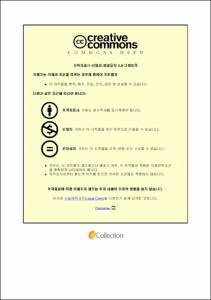Blue Laser Diode와 고출력 LED에 적용 가능한 Phosphors in Glass 제조 및 이중반사형 해상용 LED 등명기 광학 설계
- Alternative Title
- Optical design of double reflector lantern for lighthouse, and Development of Phosphors in Glass for Blue laser diode and High power LED
- Abstract
- Light emitting diodes(LEDs) have been developed as a major light source in diverse application of illumination and are still investigated widely for improving their high power and high efficiency. As a part of development of light source, blue laser diodes(LD) based white lights source becomes a next generation light source in illumination and display applications. Generally, white light can be generated from yellow emitting phosphors irradiated by blue emitting devices. However, the present LD based white light source technique has a significant problem, thermal quenching of the phosphor. Therefore, improving phosphor stability under high temperature is a rising question. To solve this problem, synthetic inorganic materials including phosphor in glasses (PiGs) have been suggested as alternative proximate phosphor types.
In this study, we synthesized PiGs composed of the tellurite glasses (TeO2–ZnO–B2O3–BaO) and Ce:YAG phosphor, and evaluated stability of these PiGs. The procedure of PiG synthesis consists of two steps, (1) preparation of mixture of tellurite glasses and Ce:YAG phosphor, and (2) fabrication of PiG via remelting the mixture. In the first step, to produce matrices, the tellurite glasses (TeO2–ZnO–B2O3–BaO) were prepared by melting the mixtures of raw materials in alumina crucibles at 1000 °C for 30 min using the combinatorial melting system. The melts were quenched on a copper plate. The synthesized glasses were crushed for obtaining the cullet with the size below 100 μm. Collected cullet were mixed with Ce:YAG phosphor. The second step is to re-melt the phosphors-mixed glass cullet at low temperature in order to prevent degradation of the phosphors during melting. Synthesized PiGs were polished at the desired thickness. PiG samples ware showed good visible transparency. The photoluminescence excitation and emission spectra of PiG samples were similar to those of Ce:YAG phosphors. The white LEDs which were fabricated by blue LED chip(460 nm) and 2.5 mm thickness of PiG(Ce:YAG 10 wt.%) exhibited the CIE 1931 chromaticity coordinates of 0.217,0.205. PiG samples were irradiated to 1.5 W blue laser. The white light intensity slightly decreased up to 10 min, and then was stabilized.
Marine lanterns are installed on light buoys for safe navigation of ships. Marine lanterns used oil in the beginning of 1900 and the light bulb in the 1950s. Since 2003, the LED marine lantern has been developed. However, only ordinary bulbs are replaced with LEDs, but the installation and configuration remain the same. Fresnel lenses are used for transmitting light in parallel. Fresnel lenses are difficult to design and require high cost. Therefore we replaced the Fresnel lens to a reflector in the marine lantern.
Illumination optics design program(LightTools) was used for simulation the light distribution according to the LED-200 standard for marine lantern. The LED module of cross type using 5 LED chips with 3 W was calculated as 441.7 cd in the simulation that satisfied the average horizontal brightness of the LED-200 standard. The LED module using 4 LED chips with 13 W was calculated as 672.3 cd. As a result, the power consumption of the simulated LED module using 3 W LED chip in was 78.3% lower than 24 W of LED-200 standard. And the power consumption of the Simulated LED module using 13 W LED chip in was 56.7% lower than 24 W of LED-200 standard.
- Issued Date
- 2017
- Awarded Date
- 2017. 2
- Type
- Dissertation
- Keyword
- Phosphor in glass LD LED marine lantern
- Publisher
- 부경대학교 과학기술융합전문대학원
- Affiliation
- 부경대학교 과학기술융합전문대학원
- Department
- 과학기술융합전문대학원 LED융합공학전공
- Advisor
- 양현경
- Table Of Contents
- 1. 서론 1
1.1 LED 와 LD를 이용한 조명 1
1.1.1 remote 형광체 2
1.1.2 단결정 형광체 5
1.1.3 투명 세라믹 형광체 7
1.1.4 형광체 분산 유리(PiG) 8
1.1.5 PiG용 유리 프릿 9
1.2 해상용 LED 등명기 10
1.3 연구 목적 10
1.3.1 PiG 10
1.3.2 이중반사형 해상용 LED 등명기 11
2. 이론 13
2.1 LED 13
2.2 백색 LED 13
2.3 Laser diode(LD) 14
2.4 형광체 15
2.5 LightTools 16
2.6 해상용 등명기 LED-200 16
3. 실험방법 18
3.1. PiG 제작 18
3.2 특성 측정 및 분석 19
3.3 이중반사형 해상용 LED 등명기 광학 설계 및 배광 시뮬레이션 21
4. 실험결과 및 분석 22
4.1 Ce:YAG 형광체 및 PiG 표면분석 22
4.2 Ce:YAG 형광체 질량비에 따른 PiG의 특성 23
4.2.1 Ce:YAG 형광체 질량비에 따른 PiG의 투과도 23
4.2.2 Ce:YAG 형광체 질량비에 따른 PiG의 여기 및 방출 스펙트럼 23
4.2.3 Ce:YAG 형광체 질량비에 따른 PiG가 적용된 백색 LED의 형광 특성 25
4.3 Ce:YAG 형광체 질량비가 10 wt%인 PiG의 두께에 따른 특성 28
4.3.1 PiG의 두께별 투과도 28
4.3.2 PiG의 두께에 따른 여기 및 방출 스펙트럼 28
4.3.3 PiG의 두께에 따른 백색 LED의 형광 특성 29
4.4 1.5 W laser diode에 적용한 PiG의 광학 특성 32
4.5 이중반사형 해상용 LED 등명기의 광학 설계 33
4.6 3 W LED칩(XB-D)을 이용한 배광 시뮬레이션 34
4.7 10 W LED칩(XHP35HI)을 이용한 배광 시뮬레이션 37
5. 결론 41
참고문헌 44
- Degree
- Master
- Appears in Collections:
- 과학기술융합전문대학원 > LED융합공학전공
- Files in This Item:
-
-
Download
 Blue Laser Diode와 고출력 LED에 적용 가능한 Phosphors in Glass 제조 및 이중반사형 해상용 LED 등명기 광학 설계.pdf
기타 데이터 / 1.4 MB / Adobe PDF
Blue Laser Diode와 고출력 LED에 적용 가능한 Phosphors in Glass 제조 및 이중반사형 해상용 LED 등명기 광학 설계.pdf
기타 데이터 / 1.4 MB / Adobe PDF
-
Items in Repository are protected by copyright, with all rights reserved, unless otherwise indicated.